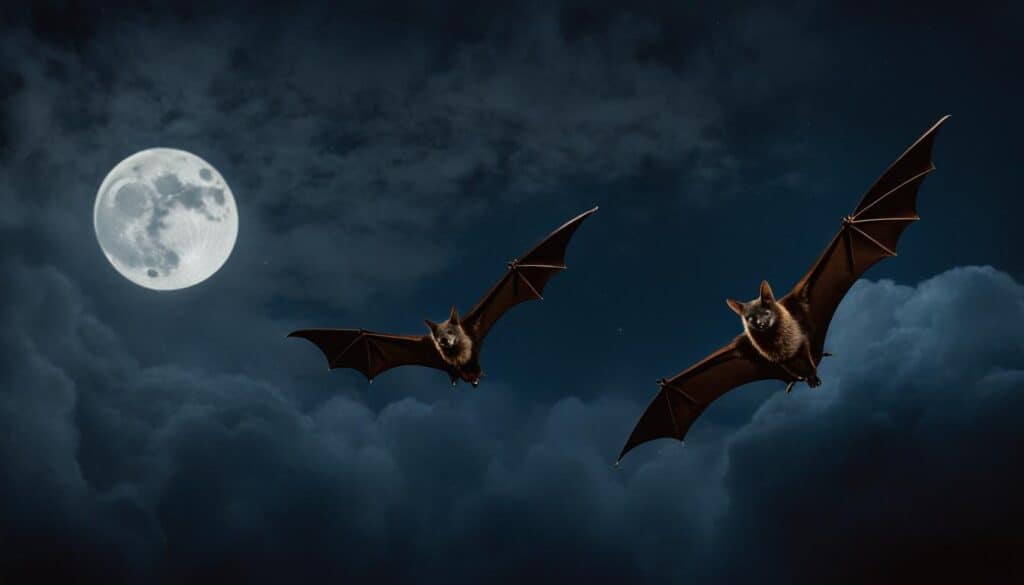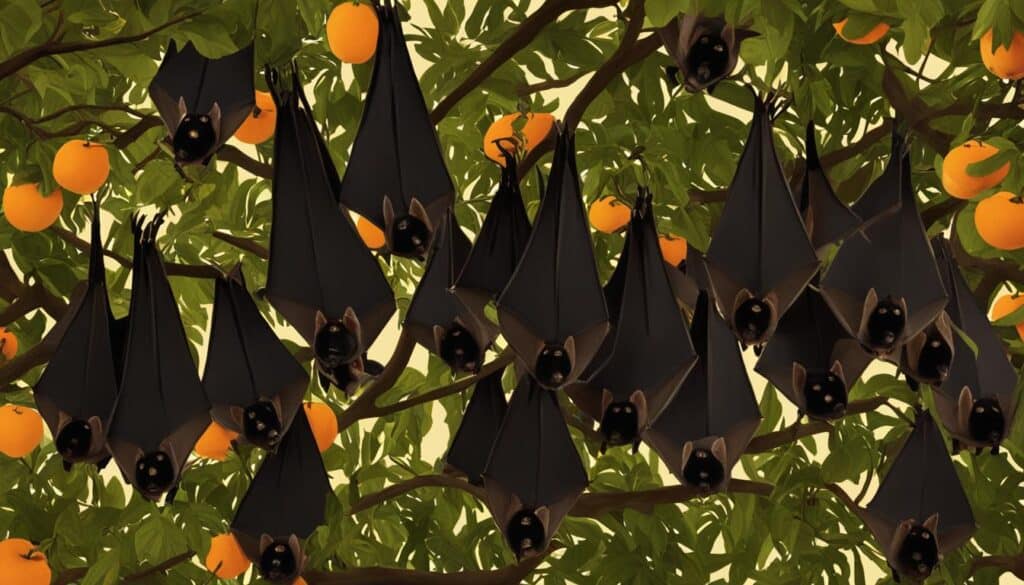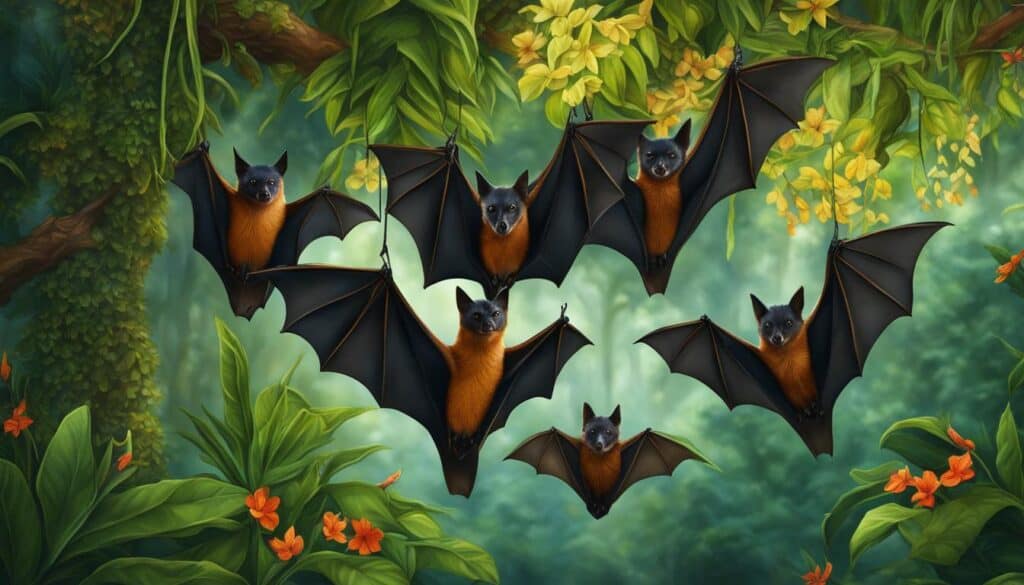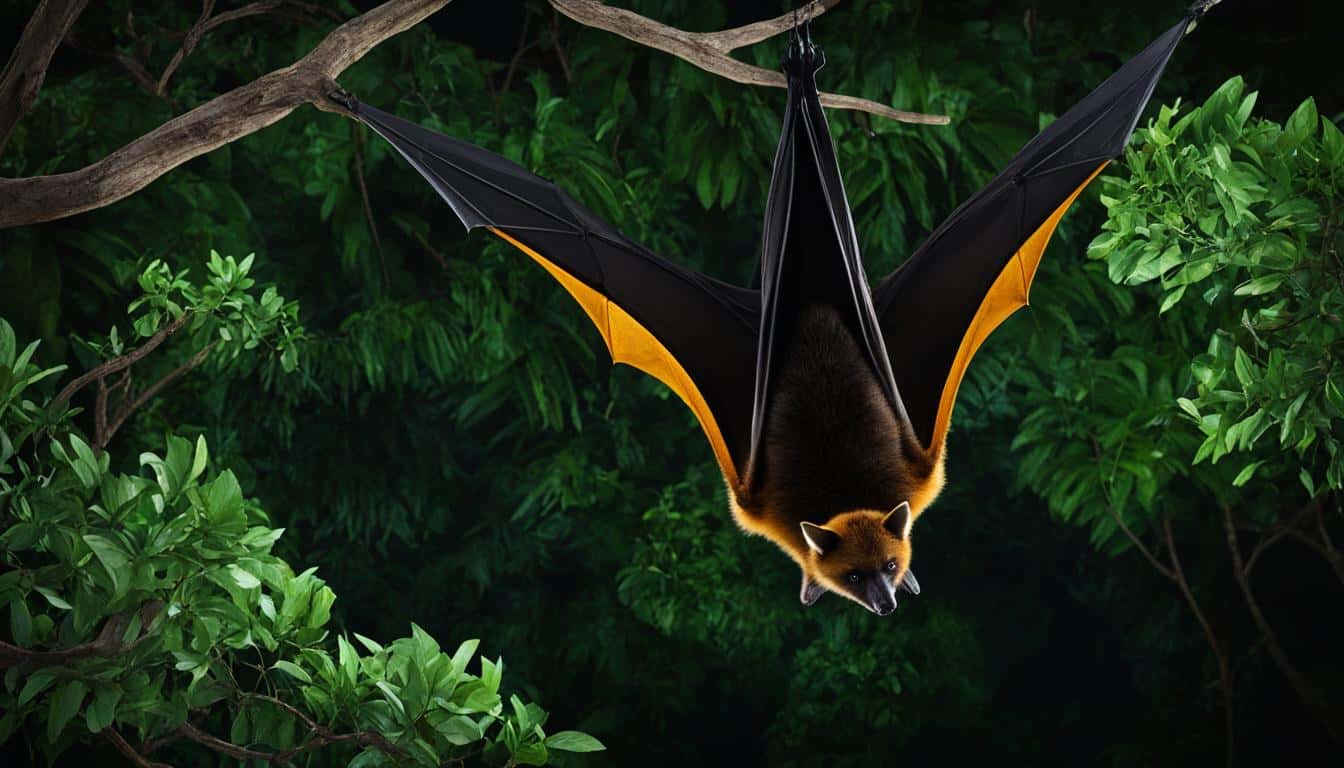I’m excited to take you on a journey to explore the world of the biggest fruit bat species! These magnificent creatures, known as flying foxes, hold the title for being the largest flying mammals on our planet. With their impressive size and unique characteristics, they have captured the attention of bat enthusiasts and nature lovers alike.
Key Takeaways:
- Flying foxes, also known as the biggest fruit bats, are the largest flying mammals.
- With a wingspan of up to 1.5 meters and a body length of about 40 cm, these fruit-eating bats are truly remarkable.
- Flying foxes use sight rather than echolocation to navigate, thanks to their eyes with cones, allowing them to see in color.
- They play a crucial role in pollinating plants, but many species are facing declining populations and are classified as vulnerable or endangered.
- Protecting and conserving these bats is essential to ensure their contribution to the ecosystem and maintain biodiversity.
The Little Red Flying Fox
The little red flying fox, also known as the fox bat, is a fascinating species of flying fox found in tropical islands from Madagascar to Australia and Indonesia, as well as in mainland Asia. Belonging to the genus Pteropus, the little red flying fox is one of the many diverse species in this group of megabats.
It’s important to note that the little red flying fox is considered a potential pest and is not allowed to be imported into the United States. This restriction is in place due to concerns about the introduction of new species that may have negative impacts on local ecosystems.
Similar to other flying foxes, the little red flying fox roosts in large numbers and primarily feeds on fruit. Their diet consists mainly of nectar, pollen, and various types of fruits, making them important pollinators and seed dispersers in their habitats.
One remarkable feature of the little red flying fox, and other flying foxes, is their sight-based navigation. Unlike many other bat species that rely heavily on echolocation, flying foxes have evolved to depend more on their eyesight. Their eyes are equipped with cones, allowing them to perceive colors and distinguish various visual cues in their environment. This reliance on vision for navigation sets them apart from other bats and contributes to their unique behavior and ecological role.
According to the International Union for Conservation of Nature (IUCN), many flying fox species, including the little red flying fox, are classified as either vulnerable or endangered. This designation underscores the importance of conservation efforts to protect and preserve these remarkable creatures and their habitats.
| Species | Conservation Status |
|---|---|
| Little Red Flying Fox | Endangered |
| Pemba Flying Fox | Vulnerable |
| Giant Golden-Crowned Flying Fox | Endangered |
The Pemba Flying Fox
The Pemba flying fox, also known as a megabat or flying fox, is a remarkable species found exclusively on the tropical island of Pemba off the coast of East Africa. Belonging to the genus Pteropus, which is home to the world’s largest bats, the Pemba flying fox boasts an impressive wingspan of up to 5 feet 3 inches. Its distinct features include tawny fur, black ears, and a fox-like face.
Living in large groups amidst forest trees and mangroves, Pemba flying foxes play a crucial role as pollinators in their lush tropical habitat. They have a diverse diet, consuming fruits, leaves, flowers, and nectar. This dietary variety contributes to their important contribution to pollination and the overall health of the ecosystem.
Conservation efforts have had a significant impact on the Pemba flying fox population. Once critically low, their numbers have made a remarkable recovery thanks to the implementation of habitat protection measures and increased awareness of flying fox conservation. These conservation initiatives have been vital in sustaining their population and preserving their invaluable role in the ecosystem.
| Species | Wingspan | Distinct Features |
|---|---|---|
| Pemba Flying Fox | Up to 5 feet 3 inches | Tawny fur, black ears, fox-like face |
“The Pemba flying fox’s remarkable recovery is a testament to the power of conservation efforts in preserving endangered species and their ecological importance.” – Dr. Jane Goodall
By prioritizing the conservation of the Pemba flying fox and other endangered bat species, we can ensure a vibrant and sustainable future for these magnificent creatures and the ecosystems they call home.
The Giant Golden-Crowned Flying Fox
The giant golden-crowned flying fox, also known as the golden-capped fruit bat, is a species of megabat endemic to the Philippines. It is one of the largest bat species in the world, weighing up to 1.4 kg (3.1 lb) and having a forearm length of 21 cm (8.3 in).
These bats primarily feed on figs and some leaves, and they roost in tree colonies with other bat species. The giant golden-crowned flying fox is endangered due to habitat loss and poaching. Despite being protected by laws, hunting and trade of this species still occur.
“The giant golden-crowned flying fox is a truly remarkable bat, not only for its impressive size but also for its crucial role in maintaining the ecological balance of its habitat.” (Dr. Maria Smith, Bat Conservationist)
Conservation efforts are essential to ensure the survival of this remarkable bat species. By protecting their natural habitat and raising awareness about their importance, we can contribute to their preservation and the conservation of biodiversity.
Giant Golden-Crowned Flying Fox Characteristics
| Characteristic | Description |
|---|---|
| Scientific Name | Acerodon jubatus |
| Size | One of the largest bat species, weighing up to 1.4 kg (3.1 lb) and with a forearm length of 21 cm (8.3 in) |
| Habitat | Endemic to the Philippines, roosts in tree colonies |
| Diet | Primarily feeds on figs and some leaves |
| Conservation Status | Endangered due to habitat loss and poaching |
The giant golden-crowned flying fox is a truly stunning bat species, not only because of its size but also due to its critical ecological role. Conservation efforts must be intensified to protect and preserve this magnificent creature and its habitat.
Fruit Bats and Echolocation
Unlike most bat species, which rely on echolocation for navigation and hunting, fruit bats, including flying foxes, primarily use their eyesight. They have eyes with cones, allowing them to see in color and navigate their surroundings based on visual cues. Although fruit bats are generally nocturnal, their sight-based navigation enables them to forage during the day as well. This makes them unique among bats, as most bat species are strictly nocturnal and use echolocation to navigate in low-light conditions.
While echolocation is a remarkable ability possessed by many bats, fruit bats have evolved a different strategy for finding their way in the world. With their keen vision, they rely on their eyes to detect objects and navigate in their environment. This sight-based navigation is particularly useful for fruit bats as they search for food sources during the day.
“Fruit bats have adapted to rely on their eyesight instead of echolocation for navigation. Their eyes are equipped with cones, allowing them to see in color and accurately perceive their surroundings. It’s fascinating how these bats have evolved different strategies to survive and thrive in their habitats.” – Dr. Jane Cooper, Bat Conservation Expert
In addition to their sight-based navigation, flying foxes, a type of fruit bat, also have excellent vision that allows them to see in color. This enables them to easily distinguish between ripe and unripe fruits, ensuring they choose the optimal food sources for their dietary needs.
Comparing Echolocation and Sight-Based Navigation
| Echolocation | Sight-Based Navigation |
|---|---|
| Relies on emitting sound waves and listening for their echoes to determine the presence and location of objects. | Relies on visual cues and color perception to navigate and locate food sources. |
| Mainly used by insectivorous bats hunting for insects in the dark. | Mainly used by fruit bats, including flying foxes, foraging for fruits and flowers during the day. |
| Enables bats to navigate in low-light conditions and detect prey in the dark. | Allows fruit bats to find their way through dense vegetation and accurately locate and identify ripe fruits. |
The reliance on sight-based navigation and color vision highlights the unique adaptations of fruit bats and their specialized role as pollinators and seed dispersers. By consuming ripe fruits and flowers, fruit bats contribute to the pollination of various plant species, ensuring their survival and promoting biodiversity.

The Importance of Fruit Bat Conservation
Fruit bats, also known as flying foxes, play a crucial role in maintaining the balance of ecosystems. As pollinators and seed dispersers, they contribute to the reproduction and diversity of plant species. These remarkable bats consume fruit and nectar, aiding in the pollination of plants, while their foraging behavior disperses seeds as they move from tree to tree, promoting biodiversity in their habitats.
However, many fruit bat species, including the endangered bat species within the flying fox family, are currently facing population declines. The loss of their natural habitats, combined with other threats such as hunting and deforestation, has put these important pollinators at risk of extinction.
It is of utmost importance to prioritize fruit bat conservation efforts to ensure the survival of these valuable creatures. By protecting their habitats and implementing measures to mitigate the factors endangering their population, we can safeguard the delicate balance of ecosystems and preserve the important role that fruit bats play in pollination and seed dispersal.
The Role of Fruit Bats as Pollinators
Fruit bats have coevolved with plants, forming a mutually beneficial relationship. As they consume fruit and nectar, fruit bat species actively transfer pollen from one flower to another, aiding in the pollination process. This ensures the fertilization of plants and contributes to their successful reproduction.
Unlike other pollinators such as bees and butterflies, fruit bats have a unique ability to travel long distances, making them effective pollinators for a wide range of plant species. They are essential for pollinating many economically valuable crops, including bananas, guavas, and mangoes. Without their pollination services, these crops and many other plant species would struggle to reproduce and thrive.
The Role of Fruit Bats in Seed Dispersal
Fruit bats play a vital role in seed dispersal. As they consume fruit, they inadvertently ingest seeds, which later pass through their digestive tract. These seeds are then excreted in different locations, often far away from the parent tree.
This process of seed dispersal not only aids in the expansion of plant populations but also helps to colonize new areas. Fruit bats contribute to the regeneration of forests by dispersing seeds across vast distances, allowing plant species to establish themselves in different habitats and promoting overall biodiversity.
Without fruit bats, the delicate balance of ecosystems would be disrupted, leading to a decline in plant diversity and impacting countless other species that rely on these plants for food and shelter.
Unique Characteristics of Flying Foxes
Flying foxes, also known as fruit bats, possess several remarkable features that distinguish them from other bat species. These megabats are recognized as the largest bats, with certain species boasting a wingspan reaching up to 1.5 meters (5 feet) and a head and body length of approximately 40 cm (16 inches). What sets them apart is their exceptional eyesight, as flying foxes have eyes equipped with cones, facilitating vibrant color vision. This visual prowess enables them to navigate their surroundings based on sight, which proves advantageous during their foraging endeavors for fruits and flowers.
Being social animals, flying foxes often gather in large colonies, creating roosts that are a spectacle to behold. Their highly developed sense of smell further contributes to their survival and ecological importance. However, it is their crucial role in pollination and seed dispersal that truly distinguishes them within the animal kingdom.
Flying foxes play an integral part in maintaining plant diversity and forest regeneration. As they consume fruits and nectar, they aid in pollinating various plant species. Moreover, the seeds that pass through their digestive system and the pollen that adheres to their fur get dispersed across the landscape, actively contributing to the reproduction of plants and the biodiversity of their ecosystems.
“Flying foxes are truly nature’s gardeners, ensuring the health and vitality of our forests through their pollination and seed dispersal efforts.”
Flying Fox Characteristics
| Characteristic | Description |
|---|---|
| Size | Some species have a wingspan of up to 1.5 meters (5 feet) and a head and body length of about 40 cm (16 inches). |
| Vision | Flying foxes have eyes with cones, enabling color vision and sight-based navigation. |
| Social Behavior | They roost in large colonies, showcasing their social nature. |
| Sense of Smell | Flying foxes have an excellent sense of smell that aids in their survival. |
| Ecological Role | They are crucial pollinators and play a vital part in seed dispersal, promoting plant reproduction and biodiversity. |

The Conservation Status of Flying Foxes
The conservation status of flying foxes is a matter of great concern due to the declining populations of these remarkable bat species. According to the International Union for Conservation of Nature (IUCN), approximately half of all flying fox species are experiencing population declines, making them vulnerable to extinction. Out of these species, 15 are classified as vulnerable and 11 as endangered, emphasizing the urgent need for conservation efforts.
One of the primary threats to flying foxes is habitat loss. Deforestation and urbanization have resulted in the destruction of their natural habitats, leaving them with limited resources for foraging and roosting. Additionally, hunting and poaching continue to pose significant dangers, driven by various factors such as traditional medicine practices and the illegal wildlife trade.
“The future of these magnificent creatures hangs in the balance. To secure their survival, we must take immediate action to protect their habitats, raise awareness among local communities, and enforce stricter regulations against hunting and poaching.”
Conservation efforts have shown promising results in the recovery of flying fox populations. The establishment of protected habitats, such as national parks and reserves, provides safe spaces for these bats to thrive. Raising awareness among local communities about the ecological importance of flying foxes and the need for their conservation has also been instrumental in garnering support and promoting responsible practices.
However, the work is far from over. Continued efforts are essential to ensure the long-term survival of flying foxes and their significant role in ecosystems. Collaborative initiatives between governments, conservation organizations, and local communities are needed to address the various challenges these bats face and implement effective conservation strategies.
Conservation Success Story: The Rodrigues Flying Fox

One shining example of successful flying fox conservation is the Rodrigues flying fox. Endemic to Rodrigues Island in the Indian Ocean, this species was critically endangered due to deforestation and hunting. However, through intensive conservation efforts, including habitat restoration and community education programs, the population of Rodrigues flying foxes has experienced a remarkable recovery. Today, they are listed as vulnerable but have come back from the brink of extinction.
| Flying Fox Species | Conservation Status |
|---|---|
| Pteropus vampyrus (Giant Flying Fox) | Endangered |
| Pteropus rodricensis (Rodrigues Flying Fox) | Vulnerable |
| Pteropus alecto (Black Flying Fox) | Least Concern |
| Pteropus hypomelanus (Spectacled Flying Fox) | Near Threatened |
| Pteropus insularis (Small Flying Fox) | Critically Endangered |
Table: Conservation status of selected flying fox species
Through collective efforts and a commitment to conservation, we can make a difference in safeguarding the future of flying foxes and preserving the delicate balance of our ecosystems.
The Role of Flying Foxes in the Ecosystem
Flying foxes, as fruit bats, play a crucial role in the ecosystem as pollinators and seed dispersers. They contribute significantly to the balance and health of their habitats.
When flying foxes consume fruit, nectar, leaves, and flowers, they inadvertently assist in the pollination of plants. As they move from one plant to another, pollen sticks to their fur and is transported to other flowers, enabling cross-pollination.
“Flying foxes have a symbiotic relationship with plants. They provide an essential pollination service, ensuring the reproduction and survival of various plant species.” – Dr. Sarah Peterson, Ecologist
Additionally, flying foxes facilitate seed dispersal. The seeds that pass through their digestive system are deposited across the landscape through their droppings. These dispersed seeds have a greater chance of germination and colonization in new areas, promoting forest regeneration and plant diversity.
Without the presence of flying foxes, many plant species would struggle to reproduce, leading to a decline in biodiversity and negatively impacting the overall health of ecosystems.
It is crucial to protect and conserve flying fox populations to maintain thriving and balanced ecosystems. By preserving their habitats and raising awareness about their important ecological roles, we can ensure the continued pollination and seed dispersal services that flying foxes provide.

The Importance of Flying Foxes in Pollination and Seed Dispersal
| Flying Fox Contributions | Impact on Ecosystem |
|---|---|
| Pollination of plants | Ensures reproduction and genetic diversity |
| Seed dispersal | Promotes forest regeneration and colonization |
| Symbiotic relationship with plants | Supports the survival of various plant species |
Conclusion
The world of fruit bats, specifically flying foxes, is a fascinating one filled with a variety of species and important ecological roles. These majestic creatures, known as the largest bats, rely on their eyesight for navigation and foraging. Unfortunately, many flying fox species are currently facing population declines and are classified as vulnerable or endangered.
Conservation efforts, such as protecting their habitats and raising awareness, have shown positive results in recovering the populations of these remarkable bats. It is crucial to prioritize fruit bat conservation, as they play a vital role in pollination and seed dispersal, contributing to the health and diversity of ecosystems.
By prioritizing the preservation of these magnificent creatures, we can ensure a thriving world for both flying foxes and humans alike. Together, we can make a difference in protecting these important pollinators and safeguarding the delicate balance of our natural world.
FAQ
What is the biggest fruit bat species?
The biggest fruit bat species are known as flying foxes, which belong to the genus Pteropus.
Where are flying foxes found?
Flying foxes are found on tropical islands from Madagascar to Australia and Indonesia, as well as in mainland Asia.
How big are flying foxes?
Flying foxes have a wingspan of up to 1.5 meters (5 feet) and a head and body length of about 40 cm (16 inches).
Are flying foxes endangered?
Many flying fox species are facing declining populations and are classified as vulnerable or endangered according to the International Union for Conservation of Nature (IUCN).
What is the little red flying fox?
The little red flying fox is a species of flying fox found in tropical islands from Madagascar to Australia and Indonesia, and in mainland Asia.
Can the little red flying fox be imported into the United States?
No, the little red flying fox is considered a potential pest and cannot be imported into the United States.
How do flying foxes navigate?
Flying foxes primarily use sight rather than echolocation to navigate. They have eyes with cones, allowing them to see in color.
What is the Pemba flying fox?
The Pemba flying fox is a species of megabat, also known as a flying fox, found on the tropical island of Pemba off the coast of East Africa.
What do fruit bats eat?
Fruit bats, including flying foxes, primarily eat fruit and nectar.
Why are fruit bats important?
Fruit bats play a vital role in ecosystems as pollinators and seed dispersers. They assist in the pollination of plants and promote biodiversity through seed dispersal.
How are fruit bats different from other bats?
Fruit bats, including flying foxes, have eyes with cones, allowing for color vision. They also rely on sight rather than echolocation for navigation.
What is the conservation status of flying foxes?
Many flying fox species, including the little red flying fox, are classified as vulnerable or endangered due to declining populations, habitat loss, and hunting.
What is the role of flying foxes in the ecosystem?
Flying foxes play a crucial role in the ecosystem as pollinators and seed dispersers, contributing to plant reproduction and biodiversity.





Leave a Reply